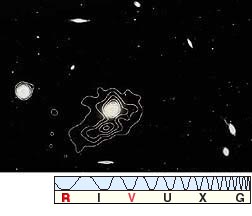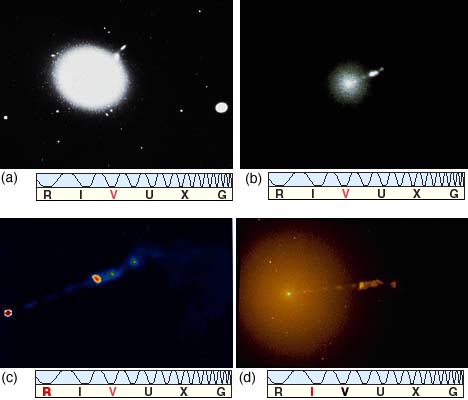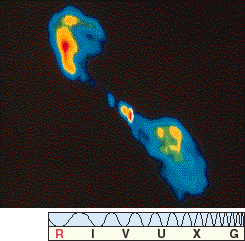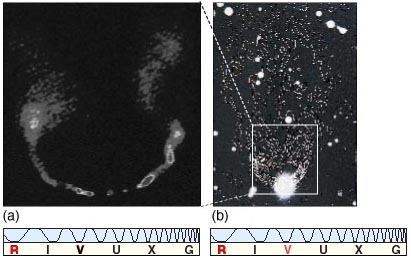As the name suggests, radio galaxies are active galaxies that emit most of their energy in the radio portion of the electromagnetic spectrum. They differ from Seyferts not only in the wavelengths at which they radiate most strongly (Seyferts tend to radiate at shorter radio wavelengths and infrared wavelengths; radio galaxies radiate at longer radio wavelengths) but also in both the appearance and the extent of their emitting regions. Whereas the nonstellar emission from Seyfert galaxies always comes from a small central nucleus, the nonstellar emitting regions of radio galaxies can be much larger—hundreds of kiloparsecs across in some cases.
One common type of radio galaxy is often called a core—halo radio galaxy. As illustrated in Figure 25.4, the energy from such an object comes mostly from an extremely small central nucleus (which radio astronomers refer to as the core) less than 1 pc across, with weaker emission coming from an extended region called the halo surrounding the nucleus. The halo typically measures about 50 kpc across, similar in size to the surrounding visible galaxy, which is usually elliptical and often quite faint. (The term visible galaxy is commonly used to refer to the components of an active galaxy that emit visible "stellar" radiation, as opposed to the nonstellar "active" component of the galaxy's emission.) The radio luminosity from the nucleus can be as great as 1037 W—about the same as the emission from a Seyfert nucleus and comparable to the output from our entire Milky Way Galaxy at all wavelengths.

Figure 25.4 Radio contour map of a typical core—halo radio galaxy. The radio emission from such a galaxy comes from a bright central nucleus, or core, surrounded by an extended, less intense halo. The radio map is superimposed on an optical image of the galaxy and some of its neighbors, shown previously in Figure 24.15.
Figure 25.5 presents several images of a nearby core—halo radio galaxy. This object is a giant elliptical galaxy known as M87—the 87th object in Messier's catalog. (We can be sure that this eighteenth-century Frenchman had no idea what he was really looking at. Nor perhaps do we!) M87 is roughly 18 Mpc distant, a prominent member of the Virgo Cluster, and one of the closest active galaxies. Its nearness and interesting activity have made it one of the most intensely studied of all astronomical objects.

Figure 25.5 The giant elliptical galaxy M87 (also called Virgo A) is displayed here at several different wavelengths. (a) A long optical exposure of its halo and embedded central region. (b) A short optical exposure of its core and an intriguing jet of matter, on the same scale as (a). (c) A radio image of its jet, on a somewhat expanded scale compared with (b). The red dot at left marks the bright nucleus of the galaxy; the red and yellow blob near the center of the image corresponds to the bright "knot" visible in the jet in (b). (d) A near-infrared image of the jet, at roughly the same scale as (c).
A long time-exposure (Figure 25.5a) shows a large fuzzy ball of light—a fairly normal looking type E1 elliptical galaxy whose full extent is about 100 kpc across (considerably larger than the view shown in the figure). A shorter time-exposure of M87 (Figure 25.5b), capturing only the galaxy's bright inner regions, reveals a long thin jet of matter ejected from M87's center. The jet is about 2 kpc long and is traveling outward at very high speed, possibly as much as half the speed of light. Computer enhancement shows that the jet is made up of a series of distinct "blobs" more or less evenly spaced along its length. This high-speed jet, which emits energy at the rate of almost 1035 W, has been imaged in the radio and infrared regions of the spectrum (Figures 25.5c and d) as well as in the visible region. Jets such as this are a very common feature of active galaxies. As we will see, they play a vital role in our understanding of these energetic objects.
Many radio galaxies are not of the core—halo type. Very little of their radio emission arises from the compact central nucleus. Instead, most of this emission comes from huge extended regions called radio lobes—roundish clouds of gas up to 1 Mpc across, lying well beyond the visible part of the galaxy. For this reason, these objects are known as lobe radio galaxies.
The radio lobes of all lobe radio galaxies are truly enormous. From end to end, the radio lobes are more than 10 times the size of the Milky Way Galaxy, comparable in size to the entire Local Group. The lobes emit no visible light, but their radio luminosity can range from 1036 to 1038 W—between 1/10 and 10 times the total energy emitted by our Galaxy. Several of these strange objects are located relatively nearby, so we can study them at close range. One such system, known as Centaurus A, is shown in Figure 25.6. It lies only 4 Mpc from Earth.

Figure 25.6 Lobe radio galaxies, such as Centaurus A shown here, have giant radio-emitting regions extending a million parsecs or more beyond the central galaxy. The lobes cannot be imaged in visible light and are observable only with radio telescopes. (The lobes are filled with false color to indicate decreasing intensity from red to yellow to green to blue.)
Figure 25.7 superposes another representation of Figure 25.6 on an optical image of Centaurus A, to show the relationship between the visible and radio emission. In visible light, Centaurus A is a rather peculiar-looking object, apparently an E2 galaxy bisected by an irregular band of dust. Numerical simulations suggest that this system is probably the result of a merger between an elliptical galaxy and a smaller spiral galaxy about 500 million years ago. The radio lobes are roughly symmetrically placed, jutting out from the center of the visible galaxy roughly perpendicular to the dust lane. The elliptical galaxy itself is very large—some 500 kpc in diameter.

Figure 25.7 An optical photograph of Centaurus A, one of the most massive and peculiar galaxies known and believed to be the result of a galaxy collision some 500 million years ago. The pastel false colors mark the radio emission shown in Figure 25.6, in this case more recently acquired and with higher resolution. Note that the radio lobes emit no visible light.
The lobes of radio galaxies vary in size and shape from galaxy to galaxy, but they are aligned with the center of the visible galaxy in nearly all cases. This alignment suggests that the lobes consist of material that was somehow ejected in opposite directions by violent events in the galactic nucleus. In the case of Centaurus A, this argument is strengthened by the presence of an additional pair of secondary lobes, smaller than the main lobes (about 50 kpc in length, marked in Figure 25.7) and closer to the visible galaxy. Both pairs of lobes share the same high degree of linear alignment. Astronomers believe that the inner lobes were expelled from the nucleus by the same basic process as the outer ones, but more recently, so they have not had time to travel as far. Still higher resolution studies reveal the presence of a roughly 1-kpc-long jet in the center of Centaurus A, again aligned with the larger lobes.
If material is ejected from the nucleus at close to the speed of light (which seems likely), it follows that Centaurus A's outer lobes were created a few hundred million years ago, quite possibly around the time of the collision thought to be responsible for the galaxy's peculiar optical appearance. Apparently, some violent process at the center of Centaurus A—most probably triggered by the merger—started up around that time and has been intermittently firing jets of matter out into intergalactic space ever since.
Further evidence in favor of the interpretation of radio lobes as material ejected from the center of a galaxy is provided by another object, Cygnus A, shown as an optical image in Figure 25.8(a) and as high-resolution radio map in Figure 25.8(b). Note the filamentary structure evident in the radio lobes and the thin, radio-emitting line joining the right lobe to the center of the visible galaxy (the dot at the center of the radio image). These features strongly suggest that we are seeing two oppositely directed, narrow jets of material running into the intracluster gas filling the galaxy cluster of which Cygnus A is a member, then slowing down and spreading out to form the radio lobes. (Sec. 24.3)

Figure 25.8 (a) Cygnus A also appears to be two galaxies in collision, although it is not completely clear that that is what is really happening. (b) On a much larger scale, this cosmic object displays radio-emitting lobes on each side of the optical image. To put these images into proper perspective, the optical galaxy in (a) is about the size of the small dot at the center of the "radiograph" in (b). Notice the thin line of radio-emitting material joining the right lobe to the central galaxy. The distance from one lobe to the other is approximately a million light years.
In some systems, known as head—tail radio galaxies, the lobes seem to form a "tail" behind the main galaxy. For example, the lobes of radio galaxy NGC 1265, shown in Figure 25.9, appear to be "swept back" by some onrushing wind and, indeed, this is the most likely explanation for the galaxy's appearance. If NGC 1265 were at rest, it would be just another double-lobe source, perhaps looking quite similar to Centaurus A. However, the galaxy is traveling through the intergalactic medium of its parent galaxy cluster (known as the Perseus Cluster), and the outflowing matter forming the lobes tends to be left behind as the galaxy moves.

Figure 25.9 (a) Radiograph, in false color, of the active "head—tail" galaxy NGC 1265. (b) The same radio data, in contour form, superposed on the optical image of the galaxy. Astronomers reason that this object is moving rapidly through space, trailing a "tail" behind as it goes—a little like a comet, but on a vastly larger scale.
Radio galaxies share many characteristics with Seyfert galaxies. Both types of active galaxies emit comparably large amounts of energy, and there is good evidence that the energy source in both is a compact region at the center of an otherwise relatively normal looking galaxy. In lobe radio galaxies, that energy is fired out from the nucleus in the form of narrow, high-speed jets of matter that travel into the intergalactic medium and become extended lobes far from the center of the galaxy. As a result, the energy from a lobe radio galaxy is ultimately emitted (in the form of radio radiation) from a region well outside the visible galaxy. It may be that the differences between core—halo and lobe radio galaxies is largely a matter of perspective (Figure 25.10). If we view the jets and lobes from the side, we see a lobe radio galaxy, but if we view the jet almost head-on—in other words, looking through the lobe—we see a core—halo system. If that is so, then in all cases studied so far the central compact nucleus is the place where the energy is actually produced. Let us now consider the current view of the "engine" that powers all this activity.

Figure 25.10 A central energy source produces high-speed jets of matter that interact with intergalactic gas to form radio lobes. The system may appear to us as either a lobe or a core—halo radio galaxy, depending on our location with respect to the jets and lobes.